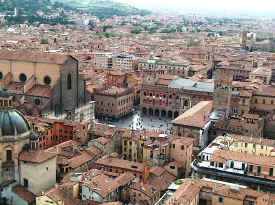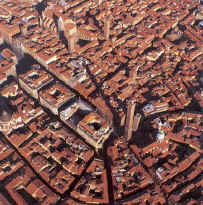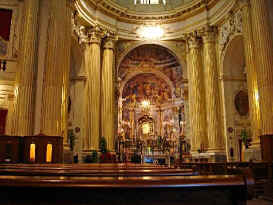Bologna HistoryBologna was founded by the Etruscans, who called it Felsina. Later it fell into the hands of the Boii, a Gallic tribe, and from that time took the name of Bononia, whence the present form. In 189 B.C. the Romans established a colony there, which was enlarged and beautified by Augustus. After Byzantium had broken the power of the Goths in Italy, Bologna belonged to the Exarchate of Ravenna (536). As a result of a donation by Pepin, Bologna was made part of the patrimony of the Holy See, but during the disturbances of the 9 C it was wrested from the popes. At the beginning of the 9 C it was laid waste during the incursions of the Hungarians. Otto I did much to restore the city to its former condition, giving it the privilege of enacting its own laws, and making it directly dependent on the imperial authority. Bologna was then governed by consuls. During the struggles between the empire and the popes, the city took the part of the latter and was enabled to assert its independence, which was definitively recognised by Henry V in 1122. Bologna was among the first to join the Lombard League. From 1153, it was ruled by podestas, who were for most part foreigners. From the accession of Frederick II, Bologna was split between Guelphs and Ghibellines, the former being in the majority. On 26 May, 1249 at the battle of Fossalto, the forces of Bologna conquered the troops of Frederick II under the leadership of King Enzo (Ezzelino). Enzo himself was taken prisoner, and neither the threats nor the promises of Frederick availed to secure his liberty. He remained in captivity until his death eleven years later.
Christianity in BolognaThe only sources for the history of the beginnings of Christianity in Bologna are legendary accounts, according to which St. Apollinaris, disciple of St. Peter and first Bishop of Ravenna, was the first to preach the Gospel in Bologna. The first bishop is said to have been St. Zama, who is supposed to have been ordained by Pope St. Dionysius (270). However, it may be maintained with certainty that Christianity, and likewise the episcopate, in Bologna dates back to a more remote period. During the persecution of Diocletian, Bologna was the scene of the martyrdoms of Sts. Vitalis and Agricola, whose bodies were interred in a Jewish cemetery and only discovered in the time of St. Ambrose, in 392, as related by him in a letter, the authenticity of which, however, is questioned. The fact is referred to perhaps by Paulinus in his life of the saint, when he speaks of Ambrose taking to Florence some relics of these martyrs. It was possibly during the same persecution that the martyrdom of St. Proculus occurred. The episcopal See of Bologna was first subject to the Metropolitan of Milan, and later, probably after Milan had fallen into the hands of the Lombards, it recognised the authority of the Metropolitan of Ravenna. In 1106 it was placed immediately under the Holy See. Finally, in 1582 Gregory XIII raised the Bishop of Bologna to the dignity of a metropolitan, assigning him as suffragans the Sees of Imola, Cervia, Modena, Reggio, Parma, Piacenza and Crema. Today, however, only Imola and Faenza are suffragan to Bologna.
Among the Bishops of Bologna worthy of note are Sts. Faustinianus, Basil and Eusebius, in the fourth century. About 400, there is a record of St. Felix, succeeded about 430 by St. Petronius, who is extolled for having restored the church of Bologna, and who later became patron of the city. His relics are preserved in the church of San Stefano. A number of the Bishops of Bologna were later raised to the papal chair, including John X, Cosimo Migliorati, who assumed the name of Innocent VII; Tomaso Parentuccelli, later Nicholas V; Giuliano della Rovere, who became Julius II; Alessandro Ludovisi, Gregory XV; and Prospero Lambertini, Benedict XIV. The last two mentioned were born in Bologna. Other celebrated bishops were: Cardinal Filippo Caraffa (1378-89); Cardinal Antonio Correr (1407-12); Blessed Nicolˇ, Cardinal Albergati (1417-34); Cardinal Lorenzo Campeggi, known for the many embassies on which he was sent to Germany and England, in connection with the Reformation and the marriage of Henry VIII (1523-25). After Bologna became an archiepiscopal see, almost all the metropolitans were cardinals, among whom may be mentioned: Gabriele Paleoti (1591-97), who left the cathedral as it exists to-day, built the episcopal palace, and endeavoured to put the Tridentine reforms into execution in Bologna; Vincenzo Malvessi (1754-75), to whom the cathedral and the seminary owed much; Carlo Opizzoni (1802-55); Michele Viale PrelÔ (1855-60); Lucido Maria Parocchi (1877-82). Bologna was also the birthplace of the following popes, in addition to the two already mentioned: Honorius II (Lamberto Scannabecchi), Lucius II (Gherardo Caccianemici dell' Orso), Alexander V (Pietro Filargo), Gregory XIII (Ugo Buoncompagni), and Innocent IX (Giannantonio Facchinetti). Churches of BolognaThe Duomo (cathedral) of Bologna. The most important of the churches of Bologna is the cathedral, dedicated to St. Peter and erected by the commune in 910 to replace the ancient cathedral which stood outside the city walls.
It was destroyed by fire in 1130, but rebuilt in 1165 and in its present form it dates from 1605, according to plans drawn by the Magenta, a
Barnabite. The fašade, however, was designed by Alf. Torreggiani, who also added the first two chapels to the church. The majority of the paintings are by famous masters,
including Ventura da Bologna, Ercole Graziani, Francesco Tadolini, Onofrio
Zanotti, del Bagnacavallo (Bartolommeo Ramenghi), Ludovico Caracci, and others. There is also a lower church with five altars. Worthy of note is a crucifix of cedar wood dating from the time of the old cathedral.
Municipal architecture of BolognaWith respect to secular architecture, the porticoes in which nearly all the roads
terminate are of great interest, as are the famous towers, particularly that of the
Asinelli, 320 feet in height, erected between 1105 and 1109, and nearby, that of the
Garisendi, built in 1110, the inclination of which, it seems, was due to a subsidence of the
earth in the 14 C, which carried away the uppermost part of the
tower. It is 154 feet in height, and has an inclination of 7.77 feet.
|


